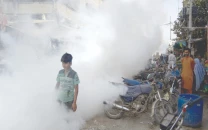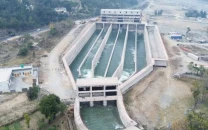Food chain: Bath at noon, liver failure at sundown
Factory issued warning after 17 buffaloes die from toxic pesticide waste.

Each noon, Mansha Gujjar’s buffaloes would amble into Rohi drain for a dip at his farm some 34km off Multan Road on the southwestern fringe of Lahore. One day last month, as the buffaloes waded in, a large tanker truck from a pesticide factory began dumping a dark liquid into the water.
“I ran and told the driver to stop but he didn’t listen,” says Gujjar. He used to own 75 buffaloes and 15 cows. Within hours of their exposure to the waste, four of the buffaloes died. Another 13 died over the next two days. Eight pregnant animals lost their unborn calves. Fifty went blind.
Gujjar has engaged a vet to treat the surviving animals. He is also concerned that the buffaloes have stopped giving milk. Even if they did, their milk and meat would be unfit for human consumption since harmful chemical compounds from the industrial waste they drank and bathed in has built up in their tissues.
The police have registered a first information report (FIR) on Gujjar’s complaint against the owners of the nearby Auriga pesticides factory, which is where the tanker came from, but he says he doesn’t think they will do anything as the factory owners had bribed them. Some two weeks since the FIR was registered, there have been no arrests.
Mohammad Ali, the factory manager, said that the buffaloes’ death could not be blamed on them. “Ours is not the only factory discharging waste water into Rohi drain. If we are, so are over a hundred other factories. They are blaming us over nothing,” he said.
He initially said that the factory dumped sewage into the drain, but later admitted that industrial waste from the 30-acre plant was also dumped there, though only after it had been “neutralised”.
Yasir Gul, an inspector with the Environmental Protection Department, said the factory had been issued a notice to install a wastewater treatment plant and to seal its septic tanks for waste disposal with cement lining, otherwise the factory could be forced shut under Section 146 (b) of the Punjab Local Government Ordinance.
This is not the first time the factory has been bought to the EPD’s notice. In August 2010, said Gul, residents of Shamkay Bhattian village complained of a strong chemical odour emanating from the factory. The factory owner was told to stop dumping wastewater in uncovered troughs and the Rohi and Hadyara drains, and to curb ammonia emissions, the source of the foul smell.
The water in Rohi drain was tested at the site in August 2010 and August 2011. Both tests indicated that its biochemical oxygen demand (BOD), chemical oxygen demand (COD), and total dissolved solvents (TDS) levels were above the minimum specified in the National Environment Quality Standards (NEQS), Gul said. This showed that the water was heavily polluted with chemical and biological waste.
An EPD laboratory officer said pesticide waste usually consisted of mixtures of chlorinated compounds and solvents such as turpentine oil. “Rejected batches are disposed of untreated. The water used to wash the machinery also contains traces of industrial chemicals and is disposed of untreated. Both are likely to affect the quality of fresh water bodies,” he said.
Vet Dr Iqbal Mushtaq said that the buffaloes would probably have died of liver failure if they had consumed pesticide waste.
He said chlorine compounds can pile up in the meat and milk and should be avoided. He said consumption of meat contaminated with chlorine compounds can also cause bones diseases such as rickets and oestomalacia.
However, he said pesticide consumption was unlikely to have caused blindness or miscarriage.
Published in The Express Tribune, September 7th, 2011.



















COMMENTS
Comments are moderated and generally will be posted if they are on-topic and not abusive.
For more information, please see our Comments FAQ